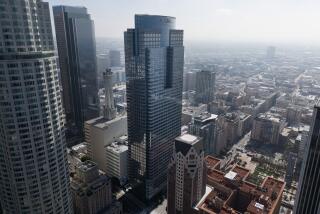Engineers shocked by towers collapse
- Share via
The World Trade Center, a symbol of American economic might, survived one terrorist attack in 1993. It was designed to withstand the impact of a jet, but both its towers collapsed this morning after planes rammed them.
The structural engineer who designed the towers said as recently as last week that their steel columns could remain standing if they were hit by a 707.
Les Robertson, the Trade Centers structural engineer, spoke last week at a conference on tall buildings in Frankfurt, Germany. He was asked during a question-and-answer session what he had done to protect the twin towers from terrorist attacks, according to Joseph Burns, a principal at the Chicago firm of Thornton-Thomasetti Engineers.
Burns, who was present, said that Robertson said of the center, I designed it for a 707 to smash into it.
Burns, whose firm did the structural engineering for the Petronas Twin Towers in Malaysia -- the worlds tallest buildings -- said Robertson did not elaborate on the remark. Robertson could not be reached early today.
Completed in 1972 and 1973, the 110-story twin towers were the fifth and sixth tallest buildings in the world. One World Trade Center, finished in 1972, was briefly after its construction the worlds tallest building. The towers have been called a monumental gate to New York and the United States.
They withstood the 1993 attack, when a bomb-laden van exploded, killing six people and injuring more than 1,000.
Closely spaced steel columns that ringed their perimeter held up the World Trade Center towers. Chicagos Aon Center (formerly the Amoco Building), completed in 1973, uses a similar support system, known to structural engineers as a tube.
Shocked by the buildings collapse, structural engineers pointed to fire as the likely cause of the structural failure.
Fire melts steel, Burns said. In addition, he said, the impact of the plane could have severely damaged the buildings sprinklers, allowing the fire to rage, despite fireproofing supposed to protect steel columns and beams.
You never know in an explosion like that whether they (the sprinklers) get cut off, Burns said.
Architects Minoru Yamasaki and Associates, in association with Emery Roth & Sons, designed the World Trade Center.
The structural engineers were the firm of Skilling, Helle, Chrstiansen, Robertson. The developer was The Port Authority of New York and New Jersey.
Todays attack marked the second time that a plane has crashed into a New York City skyscraper, although the first incident was an accident.
In 1945, a B-25 flying at 200 miles per hour slammed into the 78th and 79th floors of the Empire State Building, gouging an 18-by-20-foot hole 913 feet above the streets of Manhattan. The pilot, Lt. Col. William F. Smith Jr., had been heading from New Yorks LaGuardia Airport to Newark, N.J., when he became disoriented.
Fourteen people died in the crash and the fire that followed -- three people in the plane and 11 in what was then the worlds tallest building.
Like the World Trade Center, the Pentagon, which also was struck by a plane, provided a sizable and symbolic target.
The Pentagon is the worlds largest office building, with a total of 6.5 million square feet, serves as headquarters for the worlds most powerful military. Sears Tower, by comparison, has about 3.5 million square feet of office space.
More to Read
Sign up for Essential California
The most important California stories and recommendations in your inbox every morning.
You may occasionally receive promotional content from the Los Angeles Times.










